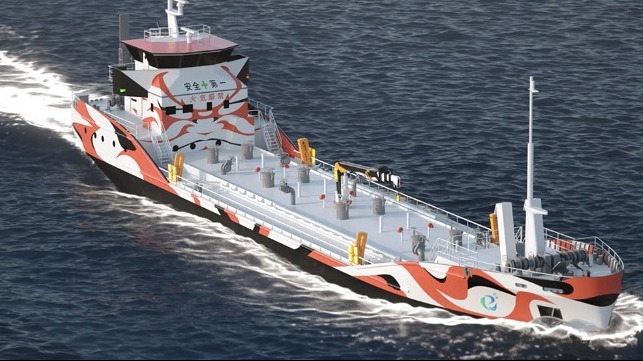Japan Proceeds with Order for Two Battery Powered Bunker Vessels

Japan’s Asahi Tanker Co. ordered two of the world’s first zero-emission electric-powered bunker vessels to operating in Tokyo Bay. The construction project will be managed by Kawasaki Heavy Industries, with one vessel built at the Koa Sangyo shipyard Marugame, Japan and the other at Imura Zosen KK in Komatsushima, Japan. No timeline was released for the construction or when the vessels would enter service.
The two tankers will be based on the e5 tanker design developed by e5 Lab. They will be powered by large-capacity lithium ion batteries using an all-electric core energy system. According to the designers, in addition to the environmental benefits, they will reduce noise and vibration, creating a more comfortable work environment for the crew members while also limiting noise pollution in Tokyo Bay.
Another unique feature of the vessels is a resigned work flow, including the adoption of various automated equipment and digital tools, including Internet of Things (IoT), in order to reduce the crew workload. This was a key consideration of Japan’s merchant marines which are both aging and declining in number. According to Asahi the applications of these technologies will increase the ship’s operating efficiency.
Asahi Tanker and TEPCO Energy Partner are also currently working on initiatives that would permit the tankers to supply emergency power in case of a disaster or emergency in the area. The concept is in effect reverse cold ironing whereby the electricity stored in their onboard batteries would serve as “large-capacity batteries for power supply in emergency” available to supply emergency power.
Plans for the two bunker vessels were first announced in the spring of 2020. In May 2020, seven Japanese companies expanded the efforts of the e5Lab with the establishment of the e5 Consortium to develop, realize, and commercialize zero-emission electric vessels. e5 stands for the five core values of the project, which are: electrification, environment, evolution, efficiency, and economics.
Specifications for the electric-powered tankers
Dimensions LOA 62m / Breadth 10.30m / Draft 4.15m
Ship classification society Nippon Kaiji Kyokai (ClassNK)
Cargo Fuel oil
Gross tonnage 499 tons
Speed About 10 knots
Cargo tank capacity 1,280m3
Propulsion equipment Azimuth thrusters 300kw x 2
Side thrusters 68kw x 2
Battery capacity 3,480kWh
